A History of the County of Hertford: Volume 3. Originally published by Victoria County History, London, 1912.
This free content was digitised by double rekeying. All rights reserved.
'Parishes: Walkern', in A History of the County of Hertford: Volume 3, ed. William Page (London, 1912), British History Online https://prod.british-history.ac.uk/vch/herts/vol3/pp151-158 [accessed 24 April 2025].
'Parishes: Walkern', in A History of the County of Hertford: Volume 3. Edited by William Page (London, 1912), British History Online, accessed April 24, 2025, https://prod.british-history.ac.uk/vch/herts/vol3/pp151-158.
"Parishes: Walkern". A History of the County of Hertford: Volume 3. Ed. William Page (London, 1912), British History Online. Web. 24 April 2025. https://prod.british-history.ac.uk/vch/herts/vol3/pp151-158.
In this section
WALKERN
Walchra (xi cent.); Walkre, Waukre, Wauker (xiii cent.).
The parish of Walkern has an area of 2,992 acres, of which 1,727½ acres are arable land, 686¾ acres permanent grass, and 138 acres woods and plantations. (fn. 1) Nearly all the western half is over 300 ft. in height; the valley of the little River Beane causes a slight depression down the centre of the parish, but the land rises again in the east, and at three points, Walkern Hall, Bassus Green, and Walkern Park, reaches a height of over 400 ft.
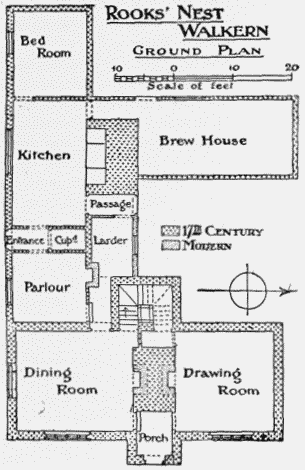
Rook's Nest, Walkern: Ground plan
The village lies off the main road in the valley of the Beane on the road to Watton. It is fairly large and somewhat straggling, the church, rectory and school, and Walkern Place, a 17th-century farm-house of timber and plaster, refaced in the 18th century, lying at the north end. There are several 17th-century cottages in the village, and the White Lion Inn, although much altered, is probably of that date. At the south end of the village are the mill on the River Beane and the early 17th-century farm-house called Rook's Nest. It is chiefly built of the narrow 2-inch red bricks, and is of two stories and attics. It is L-shaped on plan, though a long brew-house projects northward from the kitchen wing. The main building faces east, and has the usual two-storied gabled porch nearly in the centre of the front. At the back is a boldly projecting staircase carried well above the eaves of the main building and finished with a gable. A long kitchen wing facing the south projects from the main building. The main building is divided internally into two nearly equal parts by the massive substructure of the central chimney, the drawing-room or old parlour being on the right of the entrance, and the hall, now the dining room, on the left. In both these rooms the old fireplaces have been built up and modern grates substituted. A south entrance door formerly existed from the dining room. The staircase opens directly into the dining room, and the arrangement of the stair is very similar to that at Queen Hoo Hall, Tewin, and is an intermediate stage between the newel and the open stair; but in this instance the stair winds round three sides only of the timber-framed newel, which is 2 ft. 3 in. wide, and is lined up to the first floor level with old oak panelling. The panels are moulded, and inside each is a lozenge-shaped inner panel. This is the only old panelling left in the house. At the landing above are some flat-moulded balusters, cut out of 3 in. by 1¼ in. oak. The kitchen has an old fireplace 9 ft. 6 in. wide, with a plain lintel, which is partly occupied by a modern range. There is a small parlour between the kitchen entrance and the dining room. The whole of the kitchen wing is formed of timber framing, the timbers being placed close together and filled in between with thin bricks. The chimney over the main building has a group of four square shafts set diagonally on a massive square base; the chimney over the kitchen wing is of wide brickwork, with a plain sunk panel in its width. The roofs are tiled. All the windows on the east front have moulded mullions and transoms formed in cement, and over each is a brick dripstone with returned ends. All the windows on the south front have been modernized. They formerly had oak mullions and diamond-shaped lead lights.
Bridgefoot Farm, an interesting and picturesque timber-framed house, stands a little to the south-west of the church, and was probably erected about the beginning of the 17th century. It has been very little altered externally, and internally the old arrangement of the plan is still quite clear, though a few partitions have been added and the rooms modernized. The plan is L-shaped and the principal entrance is on the north side, and formerly opened directly into the common living room or hall, but this has been subdivided into a sitting-room, dairy and passage to the kitchen at the back. The beams over the hall are 17 in. wide, and the soffits are carved with a flat geometrical ornament consisting of alternate rows of four circles and four rectangular figures all connected together by fillets. There is no other carved work in the house. The old wide square-headed fireplace of the hall still remains in the sitting room, but a modern grate has been inserted and the sides filled with cupboards. To the right of the hall is the old parlour, with a wide slightly projecting bay window, which is carried up to the floor above and finished with a gable, very similar to those at Wymondley Hall and Egerton House, Great Berkhampstead. Between the parlour and the north front is a small outhouse, evidently part of the original plan. Beyond the hall, and forming the wing of the building, is the kitchen, which still retains its old fireplace, 10 ft. 6 in. in width, although it is partly occupied by a modern range. The old seats have given way to cupboards, but the small niches for flagons still remain, as at Upp Hall, Braughing. A small gabled staircase occupies the angle of the L between the old hall and the kitchen, but the stair itself is very plain. All the external walls are timber-framed, lathed and plastered on the outside, the plaster being ornamented with the usual large flush panels filled with some roughly scratched pattern. The roofs are steep and covered with tiles and all terminate in plain gables. There is an overhanging upper story on the east side. Some of the windows retain their oak mullions and transoms. The two old chimneys are groups of plain shafts of bricks 2 in. in thickness.
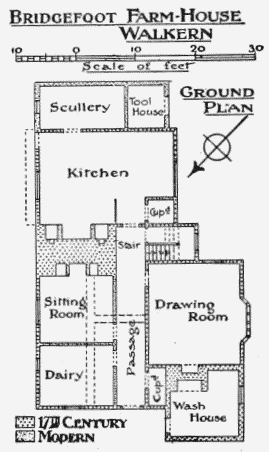
Bridgefoot farm-house: Ground plan
Three roads branching to the east run into the road to Ardeley, on the east side of which is Walkern Bury, now a modern farm-house. Adjoining it on the south is a small castle of the mount and bailey type, thrown up possibly by Hamo de St. Clare in the reign of Stephen. (fn. 2) Hamo was, we know, an adherent of the turbulent Geoffrey de Mandeville, and was with him at Stephen's celebrated Easter Court in 1136. Although the castle stands fairly high, being about 400 ft. above the ordnance datum, it does not seem to have commanded any large extent of country, and would appear to have been built at Walkern as a manorial stronghold, because that was the head of the St. Clare barony in Hertfordshire. It never apparently had any masonry works, the earthworks being defended by a wooden keep on the mound and timber stockades on the outer defences. The castle was probably destroyed, with numerous other adulterine or unlicensed castles, in the reign of Henry II.
At Clay End a road branches off still further east to Walkern Park, the residence of Mrs. Cotton Browne. Boxbury Farm and Box Wood are in the west of the parish. The parish lies on a subsoil of chalk; there are many chalk-pits and gravel-pits, especially between Walkern and the Ardeley road.
In 1403 a commission was granted to John Couper of Walkern, John Matmakere of Watton, Thomas Barbour and William Templier of Walkern 'to search for certain treasure of no small amount, which the King understands to be hidden in a pit in the field of Walkern called "Marlepitte," and to bring it when found before the King and Council with all speed.' (fn. 3)
The nearest railway station is Stevenage, on the Great Northern main line, 5 miles west. The inclosure award is dated 1850, and is in the custody of the clerk of the peace. (fn. 4)
Place-names that occur in Walkern are Tristrammes Grove, Cheney Hall and Tonecrofts.
MANORS
Walkern
In the time of Edward the Confessor WALKERN was held by Alwin Horne, one of the king's thegns. After the Conquest it was granted to Derman, a thegn of William the Conqueror, at which period it was assessed at 10 hides. (fn. 5) Derman was succeeded in the manor of Walkern, as in Watton, by his brother Leofstan, (fn. 6) but the two manors did not continue in the same hands. It seems probable that Walkern was the 'manor of Derman, which Leofstan his brother held,' given by William Rufus to Eudo Dapifer, for he seems to have possessed the tithes of Walkern, and the manor appears to have been subsequently held by his successor Hamo de St. Clare, (fn. 7) who gave the mill of Walkern to the church of St. Mary for the souls of King Henry and Queen Maud and Eudo Dapifer. (fn. 8) The manor passed from him and his wife Gunnora to their son Hubert de St. Clare, (fn. 9) who was living in the reign of Stephen, and who died in 1155. (fn. 10) Hubert's daughter and heir Gunnora married William de Lanvaley, (fn. 11) whose son William married Hawise daughter of Hugh de Bocland, (fn. 12) and was one of the barons appointed to impose the observance of Magna Charta. Hawise survived William and died before 1233, (fn. 13) her son William de Lanvaley (fn. 14) having apparently predeceased her, for his daughter Hawise, the wife of John de Burgh, (fn. 15) seems to have succeeded her grandmother. (fn. 16) John de Burgh's son John predeceased his father about 1278, when John de Burgh, senior, was said to be holding the manor by courtesy as of the barony of Lanvaley, of the heirs of John his son. (fn. 17) In 1281 John granted to Ralph de Hauville, for his service and for 100 marks, 14 acres of the demesne land 'lying between the croft that belonged to Warin de Waukre and the Greneweye and the Heldeburweye, together with Richard de Boxe, Ralph de Boxe, William de Boxe, William Aumfrey, Godahuge, Stephen de Boxe, Geoffrey son of Adam, Mila atte Holm, Isabella Ruald, Basilia Wlmer, John son of the beadle, and Walter de Boxe, formerly John's bondmen, with all their issue, chattels and tenements held by them of John in Walkern, rendering therefor two barbed arrows fledged with peacock feathers yearly at Midsummer.' (fn. 18) John de Burgh died shortly afterwards, leaving as his heirs his two granddaughters Hawise widow of Robert Grelle, and Devorgill the wife of Robert Fitz Walter, and Walkern was assigned to the latter in 1282. (fn. 19) In 1294 Robert Fitz Walter went to Gascony on the king's service and let the manor to farm in the mean time to Reginald de Silverle. (fn. 20) Devorgill died in 1284. In 1313 a purparty of her lands was assigned to her daughter and co-heir Christine, (fn. 21) who granted her reversion of this moiety to her father, (fn. 22) then holding the manor for life 'by the courtesy of England' of the inheritance of his wife. (fn. 23) Two years later Robert Fitz Walter granted the reversion of the manor after the death of a life-tenant, John Bensted, to John Lord Marshal, (fn. 24) of Hingham, co. Norfolk. (fn. 25) Upon his death without issue in 1316–17 it passed to his sister Hawise, the wife of Robert, second Lord Morley. (fn. 26) Robert died in 1360, (fn. 27) leaving a son William, the third lord, who in 1379 was succeeded by his son Thomas, fourth Lord Morley, (fn. 28) his widow Cecilia holding a third of the manor in dower until her death in 1386. (fn. 29) The fourth lord, who was Marshal of Ireland and a Knight of the Garter, died in 1416, being succeeded by his grandson Thomas. (fn. 30) Anne widow of Thomas, fourth Lord Morley, married secondly Sir Hugh Hastings, and held the whole manor until her death in 1426. (fn. 31) Thomas, fifth Lord Morley, was succeeded in 1435 by his son Robert, (fn. 32) who died in 1442, leaving an only daughter Eleanor, at that time only forty-two weeks old. (fn. 33) She subsequently married William Lovel, who was thereupon summoned as Lord Morley. They both died within a month of each other in 1476. (fn. 34) The custody of their son Henry during his minority, together with his marriage, was granted to Richard, Bishop of Salisbury, and Peter Courteney. (fn. 35) He died without issue in 1489, his lands passing to his sister Alice, (fn. 36) who married first William Parker, and secondly Sir Edward Howard, (fn. 37) afterwards Lord High Admiral. Shortly after 1506 (fn. 38) Alice and Sir Edward Howard sold the manor of Walkern to Sir William Capell, Lord Mayor of London, who died seised of it in 1515, (fn. 39) and whose descendant Arthur Lord Capell of Hadham was created Earl of Essex after the Restoration. (fn. 40) Walkern has descended in this family, (fn. 41) and is now held by the seventh earl.
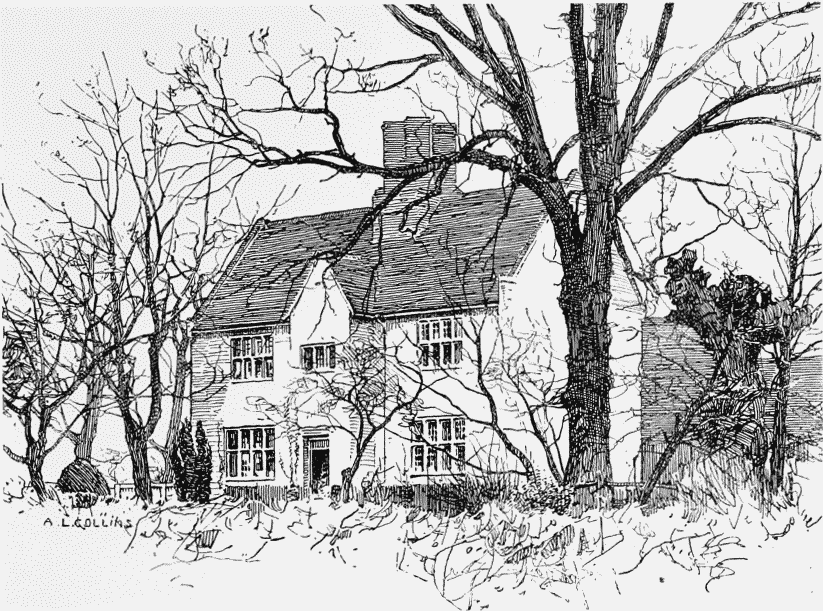
Rook's Nest, Walkern: East Front
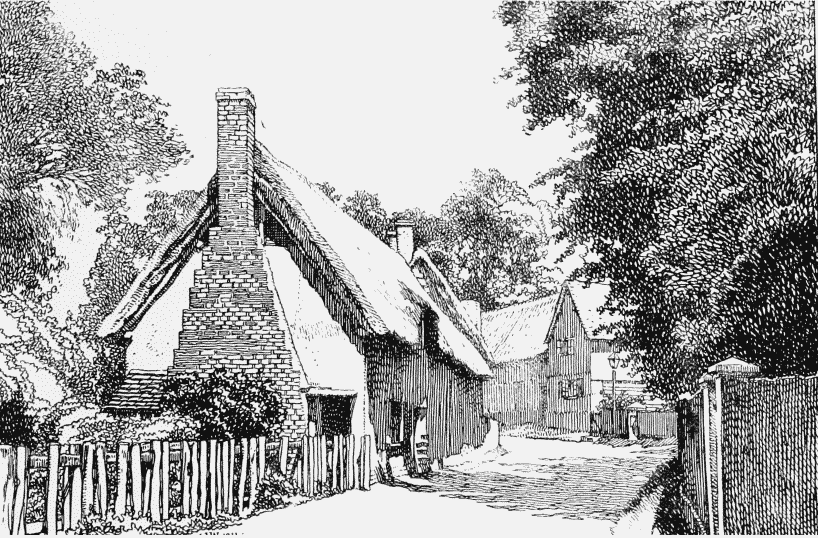
Old Cottage, Walkern
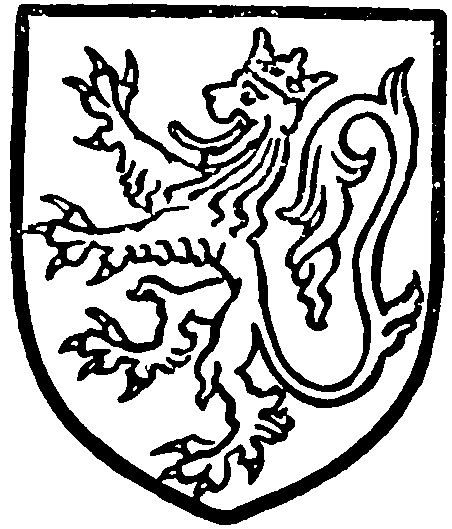
Morley, Lord Morley. Argent a lion sable crowned or.
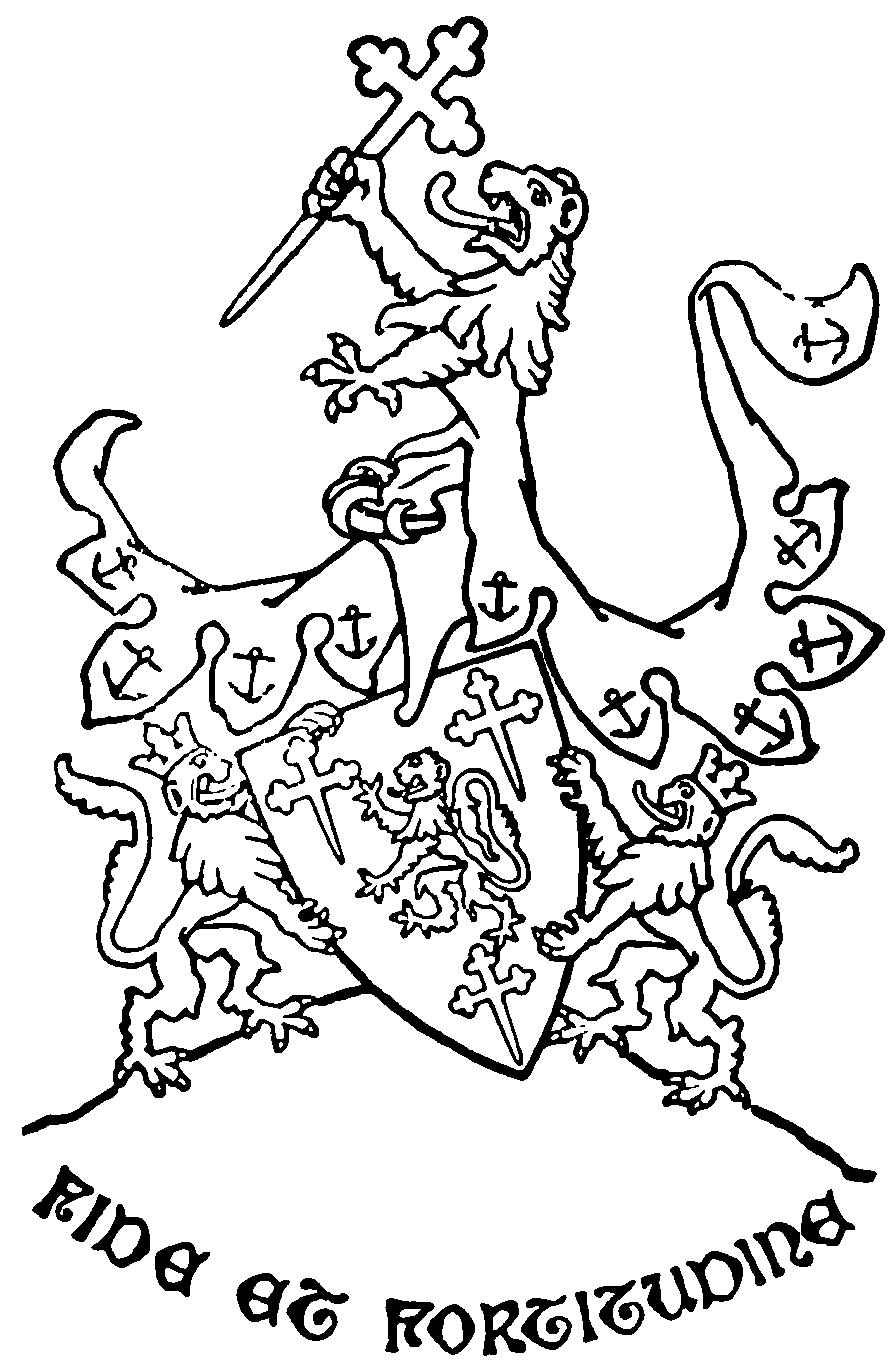
Capell, Earl of Essex
Walkern Park is first mentioned in 1360. (fn. 42) In 1373 John Basset was keeper. (fn. 43) His name perhaps and that of his family survives in Bassus Green, called by Cussans Bassett's Green. (fn. 44) In 1379 the park had an area of 398 acres, (fn. 45) and in 1435 the 'agistment' was stated to be worth 26s. 8d. beyond the sustentation of the wild animals. (fn. 46) John Hotoft was keeper in 1427 and John Humberston in 1428. (fn. 47) It is now of the extent of 30 acres and surrounds Walkern Hall.
Walkern Mill was given to the church of St. Mary of Walkern by Hamo de St. Clare in the reign of Henry I (fn. 48) (see above). In 1313 a water mill was pertaining to the manor, (fn. 49) and in 1360 a windmill is mentioned. (fn. 50) There is still a water mill.
View of frankpledge, amendment of the assize of bread and ale, gallows, tumbrel, infangentheof and free warren were claimed by Robert Fitz Walter in 1287. (fn. 51) In 1360 the court leet was held on Tuesday in Whitsun week. (fn. 52)
Boxbury or Boxe
The manor of BOXBURY or BOXE in Walkern and Stevenage was assessed in the 11th century at 5 hides. In the time of Edward the Confessor 2 hides and 3 virgates were held by Alward, a man of Alestan of Boscombe, (fn. 53) and half a hide by Samar, a man of Alnod. (fn. 54) A hide and 3 virgates also in Boxe belonged to Benington. (fn. 55) By 1086 Alward's 2¾ hides had been acquired by William de Ow, and were held of him by Peter de Valognes, (fn. 56) who had gained possession of the Benington portion, (fn. 57) and Samar's half-hide was held by Osbern of the Bishop of Bayeux. (fn. 58) These holdings may have become amalgamated, for the only manor of which later there is any evidence descended in the family of Valognes with their principal manor of Benington. (fn. 59) It was held as half a knight's fee.
The first sub-tenant of Boxbury to be mentioned is William de Boxe, who held one knight's fee in Hertfordshire of Robert de Valognes in 1166. (fn. 60) Almaric de Boxe was holding land in Walkern in 1200, (fn. 61) and his son William sued Richard de Boxe for a tenement in Stevenage in 1229. (fn. 62) Richard de Boxe obtained a grant of free warren in his demesne lands of Boxe in 1253. (fn. 63) He appears to have been succeeded by a John le Sarmonner or Summoner (see Boxe's manor of Hoddesdon in Hertford Hundred). The heirs of this John were assessed for Boxe in 1303. (fn. 64) These heirs seem to have been Thomas de Langton and Richard de St. Edmund (probably sons of his daughters). (fn. 65) Richard de St. Edmund apparently left an heiress Margery, who married Ralph de Foxton (see Hoddesdon), and in 1346 Margery de Foxton, with John de Broxbourne, Thomas Ty and John de Blomvile, was assessed for the half-fee in Boxe. (fn. 66)
After this date the history of this manor is for a long time obscure. It reappears as the manor of Boxbury in 1521, in which year John Norreys died seised of the manor, which was settled on himself and his wife Katherine. (fn. 67) His son John, who succeeded him, sold Boxbury in 1526 to Philip Boteler, (fn. 68) in whose family it descended in the same manner as Watton Woodhall (fn. 69) (q.v.) until the death of Robert Boteler in 1622. (fn. 70) Boxbury then came to his daughter Jane, who married John Lord Belasyse (fn. 71) and sold the manor some time after 1638 to Sir John Gore of Sacombe. (fn. 72) The latter conveyed it in 1681 to Thomas Ashby, (fn. 73) who was still holding it in 1727. (fn. 74) Subsequently it came into the possession of William Hale of King's Walden, who was lord of the manor in 1771, (fn. 75) and in whose family it descended. (fn. 76)
Christiana de Valognes and her descendants claimed in Boxe the same privileges which they held in their main manor of Benington (fn. 77) (q.v.).
Langtons
LANGTONS, a manor of which scanty records remain, was probably that part of Boxe which descended to the second heir of John le Sarmonner, Thomas de Langton (cf. Langtons in Hoddesdon). Later it came into the same hands as Boxbury. John Norreys died seised of it in 1521, (fn. 78) and it apparently came with that manor to Philip Boteler in 1526, for Sir John Boteler was holding it in 1562. (fn. 79) It probably became merged with Boxbury.
CHURCH
The church of ST. MARY THE VIRGIN stands to the north-east of the village on the east bank of the River Beane. It is built of flint rubble with dressings of Barnack stone and clunch, and consists of a chancel, nave and aisles, west tower, south porch and modern north and south chapels. (fn. 80)
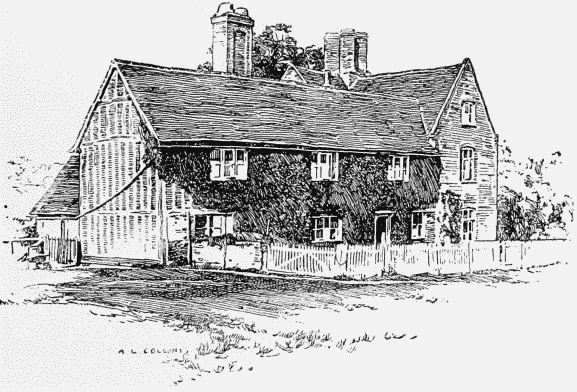
Rook's Nest, Walkern, from the South-west
The original church consisted probably of a chancel and nave. The former has been wholly rebuilt, and the earliest part of the existing church is the nave, which dates from the 11th century and is probably part of the pre-Conquest church, as the walls are only 2 ft. 3 in. thick, and over the position of the former south door is a piece of sculpture of pre-Conquest date described in detail below. The south aisle was added early in the 12th century. In the following century the chancel was rebuilt and the north aisle added. The tower was built in the middle of the 14th century. In the early part of the 15th century the south porch was added, and at the end of the same century new windows were inserted in both aisles, while early in the 16th century the clearstory was built. The north and south chapels were added and the chancel was completely restored during the 19th century. Thus the church as a whole presents a complete series of examples of architecture from the earliest to the latest of the English styles.
The east windows of the chancel are three modern lancets. The arches opening into the chapels are also modern. In the north wall is a modern single lancet, and in the south wall is a 13th-century piscina with shafted jambs, and to the west of it three sedilia of the same date separated by detached shafts. Both the piscina and sedilia are much restored.
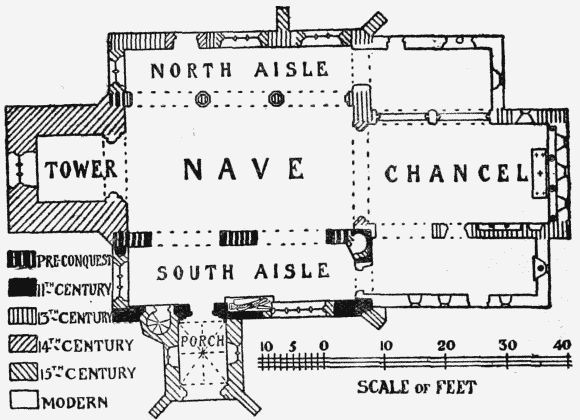
Plan of Walkern Church
The material of the two-centred chancel arch is of 13th-century date, but it has been rebuilt late in the 14th century. The nave has a north arcade of the 13th century of three bays, with two-centred arches of two chamfered orders. The columns, with their moulded capitals and bases, are octagonal. The bases are much mutilated. At the east and west ends the inner orders rest on corbels on the faces of the responds. The easternmost capital was either recut or inserted in the 15th century. The south arcade is of the 12th century, and is of two bays with semi-circular arches of one square order. The abaci are plain with one exception, which is cable-moulded. The clearstory windows, three on each side, do not correspond with the bays of the arcades. They are each of two four-centred lights with a dropped twocentred rear arch and square external head.
The north aisle has two windows of three lights in the north wall and a similar window of two lights in the west wall. All are of late 15th-century date and are much restored. The pointed north doorway, which is to the west of both the north windows, is of late 14th-century date, and is of two continuously moulded orders. The south aisle has in its east wall a modern doorway to the south chapel, and in the south wall is a late 15th-century four-light window in a four-centred head. The entrance to the rood stair is from a splay in the north-east angle of the south aisle by a doorway some height from the ground. The stair is intact, and the upper doorway to the rood loft is visible from the interior of the stair, but is quite hidden by plaster on the nave side. In the west wall of the south aisle is a window of three lights similar to that in the south wall, and traces are visible in the wall above the modern doorway in the east wall of another window of like date and detail. The south doorway is of the 12th century, and has been much restored. It has a semicircular head and shafted external jambs, the outer order being continuous. The south porch is of two stages, of early 15th-century date, and has an entrance archway with a two-centred head, the inner order supported on semi-octagonal responds and the outer continuous. The ground stage has a two-light window with a quatrefoil in a pointed head in the east and west walls. The vaulting is on the original springers, but is modern. The upper stage is approached by a stair from the aisle, its lower doorway opening to the west of the south door. The stair turret projects externally in the angle of the aisle and porch as one side and a half of an octagon. The upper stage of the porch has one two-light window in a square head in the south wall. Immediately above the doorway to the parvise stair in the aisle is one jamb and part of the rear arch of a semicircular-headed 12th-century window.
In a wide recess with a dropped two-centred head and simple continuous moulding is a fine recumbent effigy in Purbeck marble of about 1220, possibly that of William de Lanvaley, who married Hawise de Bocland. The legs are crossed and the hands are clasped on the hilt of a great sword. The figure is clad in a fine mail hauberk, with a coif and chausses without knee-cops. The long surcoat is parted above the knees, and on the left arm is a long kite-shaped shield reaching from the shoulder to below the knee. The left leg is broken, but the fragment is undamaged. The figure wears a flat-topped helm with a wide eye-slit and perforations.
On the south side of the south wall of the nave, rather westward of the middle and above the arcade, and so now included in the south aisle, are the remains of a rood of very early date, about 4 ft. 6 in. high, carved in chalk. It probably indicates the position of the original south doorway of the nave, over which it stood, and affords additional evidence of the pre-Conquest date assigned to the nave.
The west tower is of three stages with an embattled parapet and spire. The tower arch is original work of the 14th century. The west window is also of the 14th century, and has net tracery in a pointed head. The bell-chamber has single-light windows of the 15th century. On the plinths of the tower are several consecration crosses worked in scappled flints and chalk.
The roofs of the nave and aisles are 15th-century work, almost entirely plain. The font is of the late 14th century and is made of clunch, octagonal in shape and roughly moulded. It has plain sides and angle shafts.
In the chancel are the brasses of William Chapman, 1621, and his wife, 1636, with an inscription. On the north side of the nave is a brass of the late 15th century of a civilian and his wife, with a shield of arms of Humberstone; at the west end is a brass of Edward Humberstone, 1583, and his wife, which is said to be a palimpsest; it has an inscription. In the north aisle is an inscription only to William Bramfeilde, 1596; in the vestry a brass, with an imperfect inscription, to John Humberstone, 1590, and an inscription to Rychard Humberstone, 1581, which is a palimpsest on an inscription to John Lovekyn, 1370.
Besides these brasses and the 13th-century monument described above there are two 17th-century mural monuments, the one in the south wall of the chancel to Daniel Gorsuch and his wife, 1638, a classical composition with kneeling figures, and the other on the south side of the nave to Giles Humberstone, 1627, and his wife, having kneeling figures, arms and an inscription.
The small oak pulpit is of the early 16th century. It is octagonal, with plain panelled sides.
The chancel screen of five bays is of the 15th century. The upper panels of the side bays are open and traceried, and the lower are close. The centre is occupied by the doorway.
There are five bells, the first being dated 1626, by an unknown founder; the second is by Thomas Mears, 1833; and the third, fourth and fifth of 1713, by John Waylett.
The plate consists of a silver chalice and paten and almsdish, the gift of Benjamin Heath, rector, 1782.
The registers begin in 1680, and are contained in one book: baptisms 1680 to 1812, burials 1680 to 1812, marriages 1680 to 1812. (fn. 81)
Boxe is said to have anciently been a parish possessing a church. In 1700 the foundations of the church are said to have been visible in a field called the Church-yard, near Boxe Wood. (fn. 82) There is no mention of Boxe Church in the Taxation of Pope Nicholas or the Valor Ecclesiasticus of Henry VIII, but it is worthy of note that at an early date the tithes of Boxbury were in different hands from those of Walkern.
ADVOWSON
A certain Hamo, brother of Robert de Villiers, possibly a lord of the manor, gave two parts of the tithes of Walkern and a bordar with 2 acres to the monastery of St. John at Colchester. (fn. 83) William de Lanvaley, the second husband of Hawise de Bocland, gave the church to the monastery of St. John the Baptist at Colchester, (fn. 84) and in 1204 the abbot and monks were 'canonically instituted and inducted' as rectors, saving the vicarage of Geoffrey de Bocland for his life, on condition that he paid them I mark yearly. (fn. 85) No more is heard of the vicarage, so that probably after the death of Geoffrey de Bocland the monastery either served the church by one of their own monks or put in a stipendiary. The living was a rectory at the Dissolution. (fn. 86)
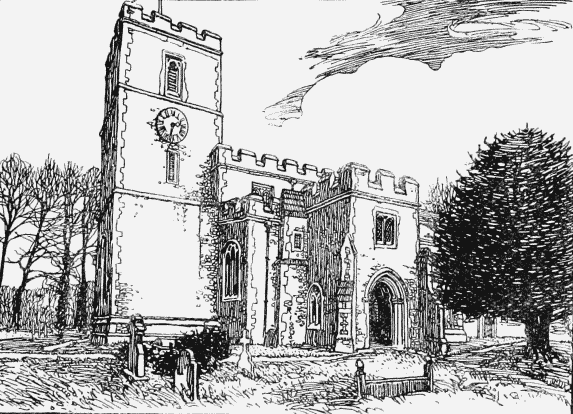
Walkern Church from the South-west
In 1546 the advowson was granted to Sir Philip Hobby and his heirs. (fn. 87) After this the descent lacks documentary evidence for more than a century. It is said to have come into the possession of John Cock of Broxbourne, whose son Henry Cock conveyed it in 1560 to Henry Willan of Kelshall, who sold it in 1564 to George Brende of London. In 1587 George Brende sold it to Edward Horne, then rector, who conveyed it in 1604 to Conant Prowse, and in 1609 the latter sold it to Agnes Wardley, widow. Five months later she conveyed it to William Humberstone of Digswell, who sold it before 1632 to Daniel Gorsuch. It was afterwards purchased by Andrew Gardiner, who conveyed it in 1669 to the Rev. Samuel Gardiner, (fn. 88) who presented in 1686. (fn. 89) It was purchased from him in 1702 by King's College, Cambridge, (fn. 90) the present patrons. (fn. 91)
The tithes of Boxbury belonged to St. Alban's Abbey before the Dissolution, and were leased in 1518 to William and Alice Day for forty years from July 1531. William and Alice sold their interests in 1519 to John Norreys, after whose death they were to come to Robert Hocknell. The latter complained that two years after this George Clarke of Walkern purchased the tithes and took them by force while Hocknell was away in France, and continued to do so. (fn. 92) Hocknell's suit appears to have been successful, for he is mentioned as holding them later. (fn. 93) The abbey leased them in 1539 to John Rotherham, (fn. 94) but Henry VIII granted them in 1544 to Richard Bowie, barbersurgeon, and John Howe, grocer, of London. (fn. 95) In the 17th century the tithes seem to have been paid partly to Walkern and partly to Stevenage, presumably according to the parish in which the lands lay. In 1671 the tithes of Boxwood, held by John or Thomas Harvey, were paid to Walkern, (fn. 96) and in 1728 tithes from part of Boxbury, owned by Thomas Adams, were paid to Stevenage. (fn. 97) Mary Adams was holding this land in 1748. (fn. 98) In 1783 tithes in the manor of Boxbury were conveyed by Rose and Mary Nicolls to Richard Down. (fn. 99)
Meeting-places of Protestant Dissenters in Walkern were certified from 1699. A Congregational chapel was built in 1810, (fn. 100) which still exists, and there is also a Baptist and a Wesleyan chapel in the parish.
CHARITIES
The charities subsisting in this parish have by a scheme of the Charity Commissioners, 8 March 1907, been consolidated and placed under the administration of one body of trustees.
They comprise the charities of:—
An unknown donor No. 1, mentioned in the Parliamentary returns of 1786, consisting of 3 a. 1 r. 31 p., known as Cadcroft Field, and 1 a. known as Brockwell Shot, in Walkern, of the annual rental value of £6.
Unknown donor No. 2, consisting of 1 a. 2 r. 20 p. in Yardley, let at £3 a year, known as Leycroft, comprised in deed of 24 January 1707.
Unknown donor No. 3, being a rent-charge of 6s. 8d. for the poor, vested in the rector of Walkern; and the charity of John Izard Pryor, being £108 11s. consols, with the official trustees, derived from will proved at London 13 July 1861, producing £2 14s. yearly.
The scheme provides that the yearly income of the charities shall be applied for the benefit of the poor in such way as the trustees may consider most conducive to the formation of provident habits, including donations to any dispensary, infirmary, provident club, provision of nurses, &c, or in distribution of articles in kind.